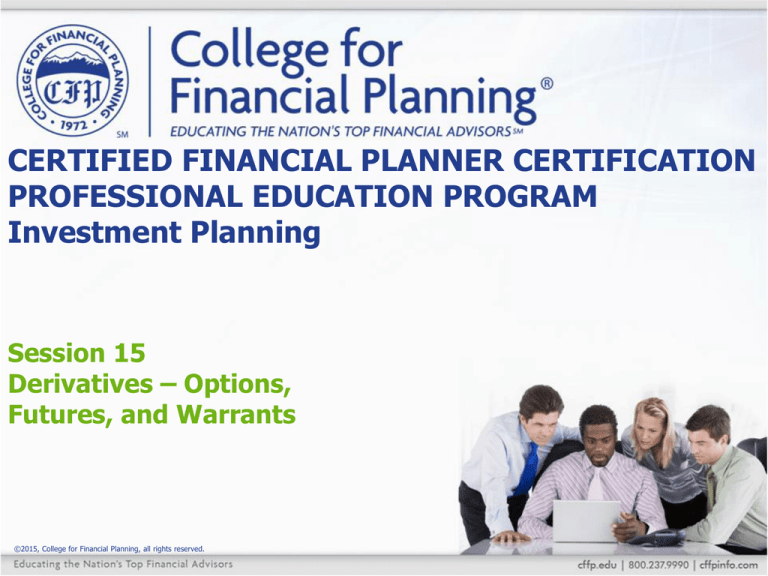
CERTIFIED FINANCIAL PLANNER CERTIFICATION
PROFESSIONAL EDUCATION PROGRAM
Investment Planning
Session 15
Derivatives – Options,
Futures, and Warrants
©2015, College for Financial Planning, all rights reserved.
Session Details
Module
8
Chapter(s) 1,2
LOs
8-1
Explain terminology, characteristics, risks,
concepts, and strategies for the use and
valuation of various types of option
investments.
8-2
Evaluate the effective use of options as
speculative investments and as hedging
instruments.
8-3
Explain terminology, characteristics, risks,
concepts, and strategies for the use of
commodity contracts.
Evaluate investor situations to recommend
appropriate hedge positions.
8-4
15-2
Option Terminology
•
a security whose value is determined by
the value of an underlying security
(“derived” from)
•
right, but not the obligation, to buy or
sell a stock at a specified price within a
specified time period
Expiration
date
•
the last date on which the option can be
exercised
Exercise
price
•
the price at which the stock can be
purchased or sold if the option is
exercised
Derivative
Option
(or strike price)
15-3
Option Terminology
Intrinsic
value
•
is the minimum price the option will
command as an option
(when an option is in the money it is the difference between
the market price and the exercise price of the stock)
Time
premium
•
is the amount by which the market price
of an option exceeds its intrinsic value
Premium
•
is the market price of the option, time
premium plus intrinsic value (if any)
LEAPS
•
long-term equity anticipation securities
15-4
Option Terminology
In-themoney
At-themoney
Out-of-themoney
•
occurs when the underlying stock of a call option is
selling above the exercise price, or when the
underlying stock of a put option is selling below the
exercise price
•
happens when the stock underlying the option (call
or put) is trading at the exercise price
•
is the term used when the underlying stock of a call
option is selling below the exercise price, or when
the underlying stock of a put option is selling above
the exercise price
15-5
Option Basics
• Buying options for speculation
• Writing covered calls for income
• Hedging by buying protective puts
15-6
The Intrinsic Value of an Option
The intrinsic value of an
option to buy stock is the
difference between
• the price of the stock,
and
• the strike (exercise)
price
15-7
At the Money
Put
Strike Price
Call
$50
$50
$50
15-8
In the Money
15-9
Out of the Money
15-10
Option Strategies
Action
Contractual Result
Buy a call
The right, but not the obligation, to buy the stock at a
specific price by a specific future date
Sell a call
The obligation (if buyer exercises option) to sell the stock
at a specific price by a specific future date
Buy a put
The right, but not the obligation, to sell the stock at a
specific price by a specific future date
Sell a put
The obligation (if buyer exercises option) to buy the stock
at a specific price by a specific future date
15-11
Options Strategies & Risk (1)
Strategy
Risk
Purchase a
call or put
Speculative investments with a limited time frame,
maximum loss is the cost of the option (premium)
Covered
call writing
Conservative strategy: keep premium but give up upside
potential – stock may be called away
Naked call
writing
Extremely risky: as stock rises loss is increasing,
theoretically an unlimited amount of loss since no limit on
how high stock can go
Naked put
writing
Moderately conservative strategy: write put options on
stocks you wouldn’t mind owning, if you have to purchase
stock risk limited as stock can only go down to zero
15-12
Option Strategies & Risk (2)
Strategy
Covered put
writing
Risk
Opposite of owning a stock and writing a covered call,
here you would short a stock and write a covered put
Protective put Strategy whereby you own stocks and want to protect
IMPORTANT! the stock or portfolio from a downturn by purchasing a
put
Straddle
Combination of a put an call on the same stock, with
the same expiration and exercise price (betting on a
large price movement, just don’t know which way)
Spread
Combining into one transaction one or more options
with different strike prices and or expiration dates—
looking to profit on change in the differential between
contracts
15-13
Black/Scholes Option Valuation Model
Value of an option depends on
• current market price of the
stock
• strike (exercise) price of
option
• length of time until the
option's expiration
• variability
(standard deviation)
of the stock’s return
• risk-free rate
15-14
Call Options
• Call options to buy
o are created by investors
• Warrants are also an
option to buy but
o are created by
corporations
15-15
Warrants
Warrants
Call Options
Sold by corporations
Sold by individuals and
institutions
Expiration typically several
years out
Expiration typically less than
1 year
If exercised, proceeds go
to company which issues
stock
If exercised, option writer
delivers stock to option
purchaser
15-16
Commodity & Financial Futures
A formal agreement
(contract) for the
delivery (seller) or
• receipt (buyer) of a
commodity
Participants in futures
markets are either
• speculators or
• hedgers
15-17
Futures Terminology
Long position
• when an investor purchases a contract for future
delivery
Short position
• when an investor sells a contract for future
delivery
Futures price
• price in the contract for future delivery of an
asset
Spot price
• current price of the asset in the cash market
Speculators
(if you were to buy a commodity right now “on the spot”)
• rarely take delivery of an asset
(usually a speculator will offset the contract before the delivery date)
15-18
Futures Leverage Example: Gold
•
•
•
•
•
Gold contract is 100 troy
ounces, assume current price is
$1,700 per ounce
Value of contract is $170,000
Initial margin requirement is
$7,425 (4.37% of the contract
value)
Maintenance margin is $6,750,
so decline in gold price of just
over $6.75 (100 ounces x $6.75
= $675 loss) would generate a
margin call
($7,425 - $675 = $6,750)
Must meet margin call
immediately
15-19
Hedging
Hedging is the procedure for reducing risk
of loss by taking the opposite position in
an asset
• Short hedge: If long, then go short ― for example, a
•
wheat farmer (who is long wheat) would then short
(sell) wheat futures as a hedge (against lower prices)
Long hedge: If short, then go long ―
for example, a baker who uses wheat is
short wheat, so the baker would go
long (buy) wheat futures as a hedge
(against higher prices)
15-20
Hedging Examples
What type of hedge would you enter into if
• you were a gold mining company?
• you were a jeweler?
15-21
Question 1
Which of the following would purchasing a stock
index option potentially allow an investor to do?
I. participate in market movements
II. hedge a portfolio
III.limit the amount at risk to the amount invested
IV. receive premium income
a. I and II only
b. I, II, and III only
c. I, II, and IV only
d. II, III, and IV only
e. I, II, III, and IV
15-22
Question 2
Your client, Tony “Tiger” Jones had purchased
10 puts on XYZ Enterprises with a strike price of
$45. XYZ is currently trading at $43 per share.
You would advise Tony that
a. the options are “in-the-money” by $1,000.
b. the options are “in-the-money” by $2,000.
c. the options are “out-of-the-money” by
$1,000.
d. the options are “out-of-the-money” by
$2,000.
15-23
Question 3
Which of the following statements is true?
a. If the strike price is less than the market
price, then a put option is “in-the-money.”
b. If the market price and the strike price are
the same, then the option is said to be “inthe-money.”
c. If the market price is greater than the strike
price, then a call option is “out-of-themoney.”
d. If the strike price is greater than the market
price, then a call option is “out-of-themoney.”
15-24
Question 4
Rank the following strategies from most
conservative to the riskiest.
a. covered call writing, call purchase, naked call
writing
b. covered call writing, naked call writing, call
purchase
c. call purchase, naked call writing, covered call
writing
d. naked call writing, call purchase, covered call
writing
15-25
Question 5
All of the following, according to Black-Scholes,
would cause the value of a call option to
increase, except an
a. increase in the current market price of the
underlying stock.
b. increase in the risk-free rate.
c. increase in the standard deviation of the
stock.
d. increase in the length of time until
expiration.
e. increase in the strike price of the option.
15-26
Question 6
Which of the following statements is incorrect
when comparing options and warrants?
a. Warrants are often issued along with bonds.
b. Options are sold by an individual option
writer, whereas warrants are issued by
corporations.
c. Warrants, unlike options, do not have market
risk.
d. Warrants typically have longer expirations
than options.
15-27
Question 7
Frances Farmer has been raising corn for use in
ethanol fuel. She believes prices are near their
peak, and she wants to “lock in” the current
price.
She would enter into a
a. long hedge, as a hedge against lower prices.
b. short hedge, as a hedge against lower
prices.
c. long hedge, as a hedge against higher
prices.
d. short hedge, as a hedge against higher
prices.
15-28
Question 8
Which of the following statements comparing
commodity futures and options is correct?
a. Purchasing an option and going long on a
futures contract carries approximately the same
amount of risk.
b. Option traders pay a premium, whereas futures
traders are required to make a good faith
deposit.
c. Individuals and institutions trade options, but
only institutions trade in commodity futures.
d. Futures can be used for hedging, but options
cannot.
15-29
Question 9
Which of the following is a feature associated
with investing in futures contracts?
a. Profits increase in a short position in futures
when the spot price increases.
b. Open interest always declines as commodity
futures contracts approach expiration.
c. Futures prices will follow the spot price more
closely as the contract expiration date
approaches.
d. Most futures contracts are settled by either
delivering or receiving the underlying
commodity.
15-30
Question 10
Sam creates large sculptures for office buildings, and
uses a large amount of copper in his sculptures. He has
several large orders he will need to complete over the
next year, and he is concerned about the direction of
copper prices.
To protect himself he would
a. buy a futures contract, called a long hedge, to
protect against the price of copper increasing.
b. buy a futures contract, called a short hedge, to
protect against the price of copper increasing.
c. sell a futures contract, called a long hedge, to
protect against the price of copper increasing.
d. sell a futures contract, called a short hedge, to
protect against the price of copper increasing.
15-31
CERTIFIED FINANCIAL PLANNER CERTIFICATION
PROFESSIONAL EDUCATION PROGRAM
Investment Planning
Session 15
End of Slides
©2015, College for Financial Planning, all rights reserved.





